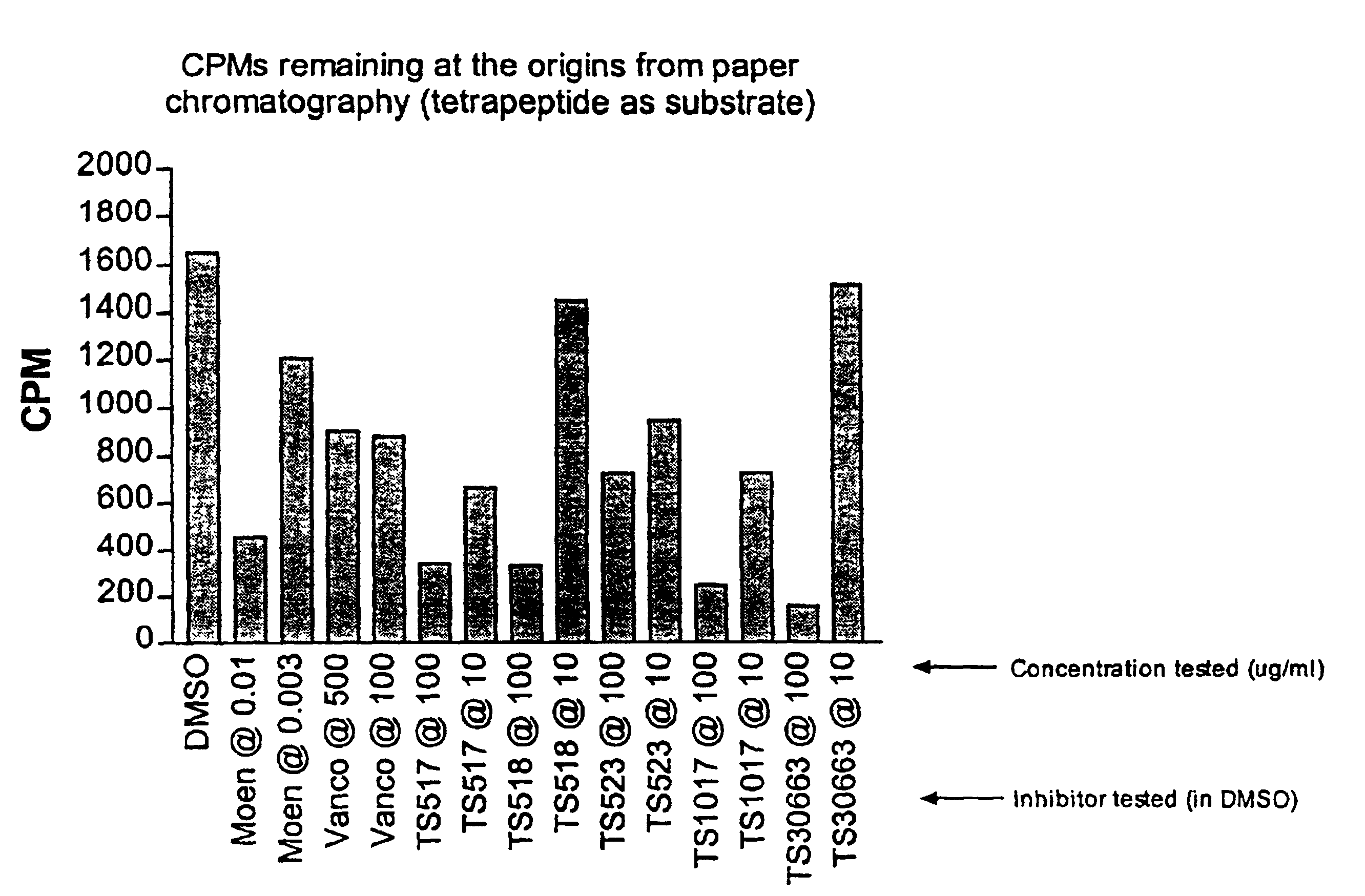Methods for assaying transglycosylase reactions, and for identifying inhibitors thereof
a transglycosylase and reaction technology, applied in the field of bacteria transglycosylase reaction, can solve the problem that one of skill in the art would still be unable to determine whether the inhibitory effect is being asserted
- Summary
- Abstract
- Description
- Claims
- Application Information
AI Technical Summary
Benefits of technology
Problems solved by technology
Method used
Image
Examples
example 1
Accumulation of Lipid II Using Triton X-100®
[0062]Assay conditions used for the formation of lipid II were exploited to preferentially prevent the formation of peptidoglycan from lipid intermediates, but still allow the formation and accumulation of lipid II in situ. For this Example, and those that follow, Triton X-100® was used, which demonstrated inhibition of the formation of peptidoglycan when used at 0.1% concentration, while not affecting the formation of lipid II. Previous experimental data had shown that 0.01% Triton X-100® did not inhibit peptidoglycan formation. As described above, however, any reversible transglycosylation blocker may be used.
[0063]Reactions were performed in the following buffer: 50 mM Tris (pH=8.0), 42 mM MgAc, 208 mM KCl, and 0.1% Triton X-100®. Each reaction was performed in a 50 ul reaction volume, containing 25 μg French Pressed bacterial membranes, 0.5 nmoles biotinylated UDP-MurNAc-pentapeptide 10% DMSO final concentration (added in conjunction w...
example 2
Comparison Using Moenomycin With and Without Blocker
[0066]The present inventors developed a method for using the endogenous production of lipid II for the specific purpose of identifying inhibitors of the transglycosylation step. The sensitivity of the assay to moenomycin was tested and compared to peptidoglycan inhibition in assays where no transglycosylation blocker was used. Moenomycin, a known inhibitor of the transglycosylase-mediated transglycosylation reaction, had identical IC50 values between the two sets of data, confirming that the assay of the invention may be used to identify those compounds that have as yet an unknown ability to inhibit the transglycosylation step. Thus, the addition and subsequent removal of a transglycosylation blocker does not impair the ultimate total production of peptidoglycan; it simply arrests the pathway at a stage convenient for scientific analysis.
example 3
Identification of Inhibitors of Transglycosylation
[0067]The above-described methods of the invention were used to analyze the activity of three inhibitors. The assay included separate samples of tunicamycin, moenomycin, or bacitracin in various concentrations. These inhibitors were added to their respective samples after formation of lipid II, with the subsequent removal of the transglycosylation blocker Triton X-100®. After 2 hours incubation, aliquots of the solubilized products were analyzed by ascending paper chromatography. The amount of lipid II converted into peptidoglycan is represented by the amount of radioactivity measured in CPM remaining at the origin for each reaction. Tunicamycin had no measurable effect on peptidoglycan production, which was to be expected because tunicamycin is known to inhibit MraY, and thus inhibits at an earlier stage than transglycosylation, and the inhibitors were each added after the accumulation of lipid II. Moenomycin's effects appear substa...
PUM
| Property | Measurement | Unit |
|---|---|---|
| volume | aaaaa | aaaaa |
| chemical state | aaaaa | aaaaa |
| molecular weight | aaaaa | aaaaa |
Abstract
Description
Claims
Application Information
 Login to view more
Login to view more - R&D Engineer
- R&D Manager
- IP Professional
- Industry Leading Data Capabilities
- Powerful AI technology
- Patent DNA Extraction
Browse by: Latest US Patents, China's latest patents, Technical Efficacy Thesaurus, Application Domain, Technology Topic.
© 2024 PatSnap. All rights reserved.Legal|Privacy policy|Modern Slavery Act Transparency Statement|Sitemap



